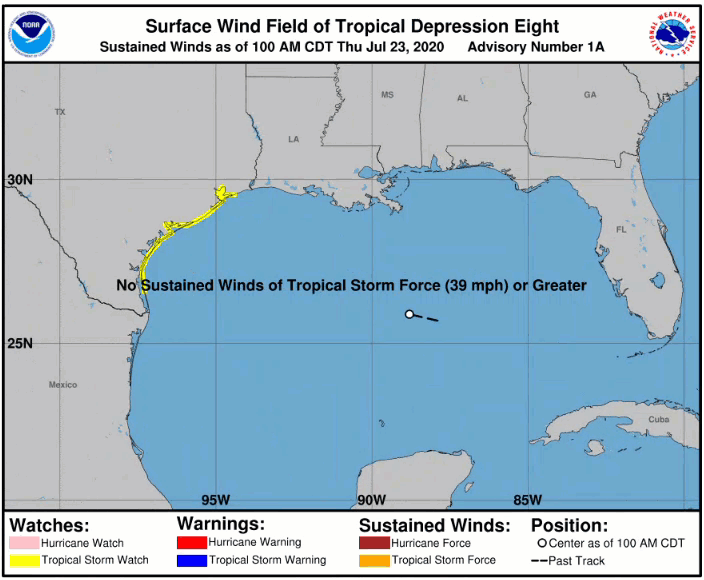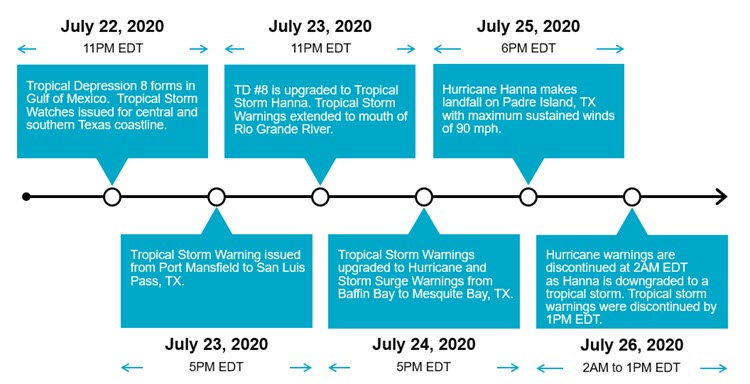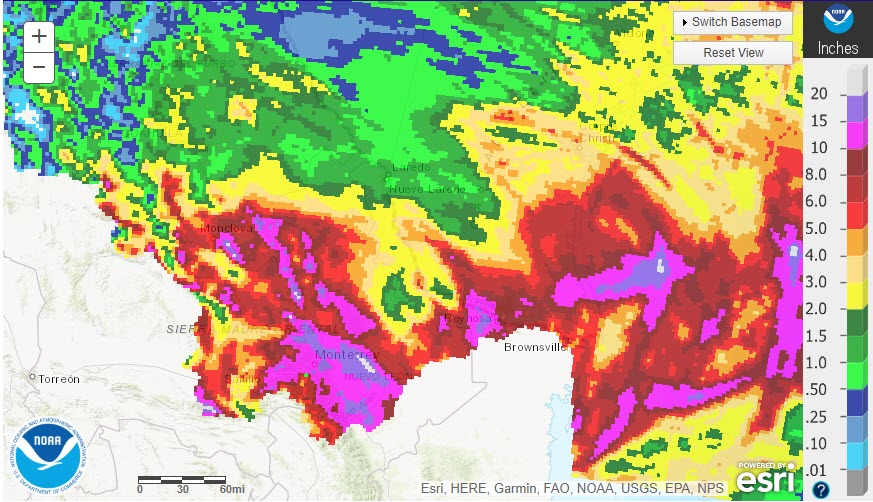
Hurricane Hanna, the eighth named storm and first hurricane of the 2020 Atlantic season, made landfall in South Texas at 6PM EDT, July 25, 2020 as a category-1 hurricane. This is the highest number of named storms in the Atlantic this early in the season, according to the known historical record, and is one storm ahead of the hyperactive 2005 season.
Physical Discussion
The National Hurricane Center (NHC) began issuing advisories on the disturbance ultimately becoming Hurricane Hanna across the western Gulf of Mexico roughly 15 hours before landfall. Hanna is the first storm to reach hurricane strength of the eight storms so far this season, just fifteen hours prior to landfall. The animation below highlights the progression of Hanna’s track from July 23 through July 27 across the Gulf of Mexico.

Surface wind field, track, watches and warnings associated with Hurricane Hanna. Source: NHC
Key events in terms of development, intensification, and decay, along with the issuance and ending of watches and warnings, are highlighted in the timeline below.


Key events and landfall statistics associated with Hurricane Hannah. Source: NHC
Hanna intensified by 35 knots (40 mph) within 24 hours prior to landfall, a case of rapid intensification. While northerly wind shear impacted Hanna in the central Gulf of Mexico, shear decreased while Hanna tracked over sea surface temperatures of 28C -29C warm enough to intensify quickly prior to landfall.
Hurricane Hanna track, position reports and associated windfield. Source: NHC[/caption] Hanna intensified as the inner core of the tropical storm contracted, allowing for the eyewall to further organize just prior to crossing the southern Texas coastline. Hurricane force winds extended 30 miles from the center of circulation while tropical storm force winds extended to 90 miles as Hanna made landfall, before moving inland across south Texas and far northern Mexico.
Hurricane force wind gusts were observed in Port Mansfield at 87 mph, while storm surge levels reached 3-4 feet above average south of Corpus Christi in Matagorda Bay and Port Lavaca. The largest impact from Hanna was the torrential rainfall as the storm dissipated inland, with totals in excess of 10 inches in both Texas and the Mexico state of Nuevo Leon, with peak totals in Mexico potentially eclipsing 20 inches as estimated by radar totals.

Rainfall totals associated with Hurricane Hanna across the Gulf of Mexico, Texas and Mexico. Source: NWS
Impacts
Media reports indicate considerable impacts due to inland flooding, with some reports of property damage due to wind and seawater inundation. Reports of downed trees and powerlines along with resulting power outages are widespread, along with transportation disruption. At least two fatalities have been reported along with four missing due to flood effects in Mexico. Industry loss estimates have not yet been issued as of Monday July 27, 2020 at 5PM EDT.
Texas
Media reports indicate considerable impacts due to flooding and wind across southern Texas. More than 283,000 homes and businesses were without electricity, falling to 98,000 by Sunday night. The Federal Emergency Management Agency approved an emergency declaration that will provide federal aid. Flood impacts were widespread and locally severe in the State of Texas.
A flash flood emergency was declared in Mission, Texas, where as much as ten inches of rain fell, according to media reports. Officials with the city of Mission asked people to stay away because motorists were becoming stranded in floodwaters and forcing first responders to engage.
A flash flood emergency also was declared for frontage roads and city streets around U.S. Highway 83 in Hidalgo County. In the meantime parts of North Beach in Corpus Christi remained underwater on Sunday. North Beach also remained closed to cars and pedestrians. Three people had to be rescued from a sailboat sinking in Corpus Christi's Marina del Sol late Saturday.
Water rescues also were needed in Hidalgo County, and major flooding was reported in Edinburg, McAllen, Mission, San Juan, and Weslaco. Meanwhile Hidalgo County Judge Richard Cortez said the county received eight to twelve inches of rain and it could take 24 to 48 hours for resulting waters to drain downstream; many vehicles were stranded and power lines were down, and affected residents were evacuated.
A portion of the Bob Hall Pier in Corpus Christi also washed away, and floodwaters reached the Art Museum of South Texas. Flooding also occurred in the downtown area, according to media reports. Hanna also produced widespread wind impacts in affected areas of south Texas. Media reports indicate that roofs were removed from buildings in Willacy County.
Meanwhile in Port Mansfield, winds flattened sugarcane fields and leveled trees. An airport manager also reported planes were moved and windows blown out of buildings at the Brownsville South Padre Island International Airport during a possible tornado. The airport perimeter fence was also damaged. In the meantime wind gusts tipped at least three tractor trailers and a recreational vehicle, with towing activity shutting down a 2-mile (3.2-km) stretch of U.S. Route 77 in Sarita, Texas, near the Mexican border. The roof of a funeral home in Edinburg also collapsed overnight, according to media reports.
Mexico
Heavy rainfall and wind gusts continue to affect Mexico. In Reynosa, a maternity hospital was damaged by heavy rain and water had to be pumped out, according to media reports. Some patients had to be moved to upper floors, and a few were evacuated to other hospitals. Meanwhile authorities report that some families were trapped in their homes in Reynosa. Reports also indicate that three children were swept away by floodwaters in the Reynosa Paseo neighborhood. A nearly 30-mile stretch of the Monterrey-Reynosa Highway was closed by flooding and several cars were stranded on the roadway. Several trees were downed by wind gusts and saturated soils in Monterrey, according to media reports.
COVID-19 Impacts
This is the first landfalling hurricane during the COVID-19 pandemic. Texas Governor Greg Abbott issued a disaster declaration for 32 South Texas counties while much of the region has been dealing with a surge in COVID-19 cases in recent weeks, according to media reports. Due to overcrowding in designated shelters, Abbott indicating some sheltering would take place in hotel rooms so people could still be physically separated. Henry Van De Putte, CEO of the Red Cross Texas Gulf Coast chapter, said the organization would open more shelters with reduced capacity to ensure social distancing.
Volunteers and people seeking refuge will undergo temperature checks, and a medical professional will be assigned to each location. Facemasks were mandatory for any evacuees sheltering in public facilities across the state. A community building known as the “Dome” in Mercedes, Texas, was reserved for evacuees who had tested positive for COVID-19 or were exposed to the virus. Across the region, shelters were also opened in hotels, schools and gyms. In the northern Mexico states of Tamaulipas and Nuevo Leon, shelters were disinfected ahead of the worst impacts of Hanna from primarily heavy rainfall and inland flooding.
Sources:
Poweroutage.us, Associated Press, The Weather Channel, Reuters, U.S. National Weather Service, U.S. National Hurricane Center, The Dallas News, Agence France Presse.
